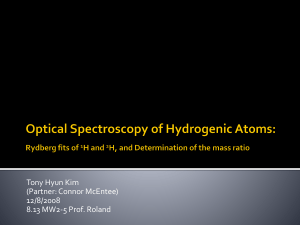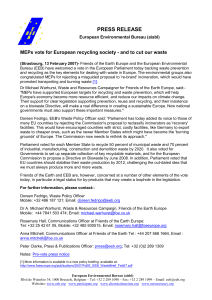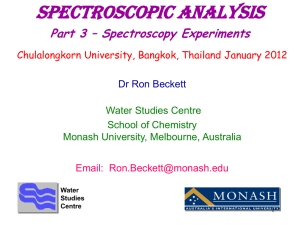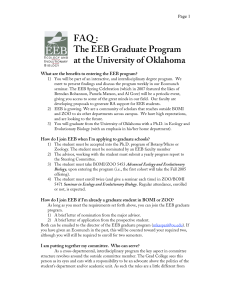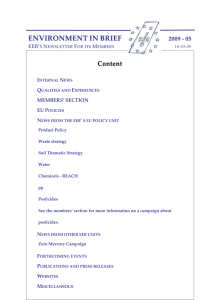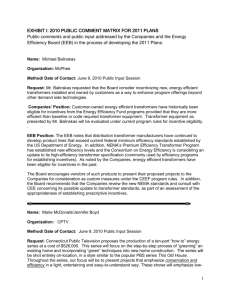Háskóli Íslands Raunvísindadeild,
advertisement
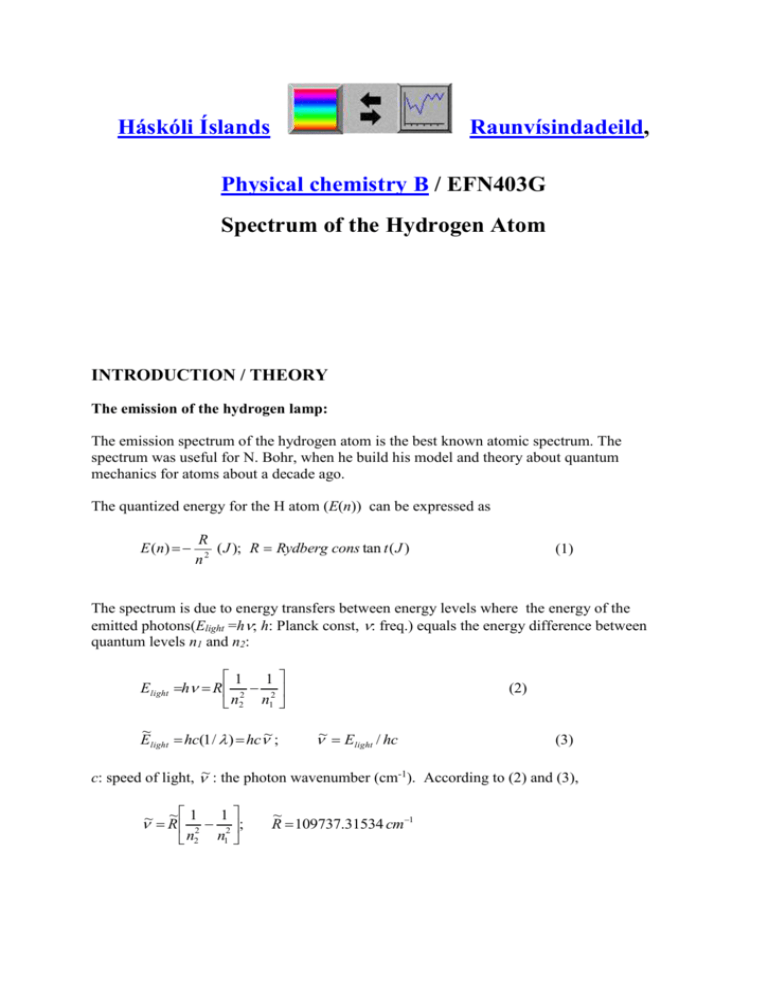
Háskóli Íslands Raunvísindadeild, Physical chemistry B / EFN403G Spectrum of the Hydrogen Atom INTRODUCTION / THEORY The emission of the hydrogen lamp: The emission spectrum of the hydrogen atom is the best known atomic spectrum. The spectrum was useful for N. Bohr, when he build his model and theory about quantum mechanics for atoms about a decade ago. The quantized energy for the H atom (E(n)) can be expressed as E ( n) R ( J ); R Rydberg cons tan t ( J ) n2 (1) The spectrum is due to energy transfers between energy levels where the energy of the emitted photons(Elight =h; h: Planck const, : freq.) equals the energy difference between quantum levels n1 and n2: 1 1 Elight h R 2 2 n2 n1 ~ Elight hc(1 / ) hc~ ; (2) ~ Elight / hc (3) c: speed of light, ~ : the photon wavenumber (cm-1). According to (2) and (3), ~ 1 1 2 ; 2 n2 n1 ~ R ~ R 109737.31534 cm1 Spectra lines due to transitions from quantum levels n1 = 3,4, ... to n2 = 2 are named Balmer lines and appear in the visible spectral region. If you plot up ~ as a function of 1 the Rydberg constant () can be obtained from the n12 slope of a line fit as described in supporting material / http://www3.hi.is/~agust/kennsla/ee10/eeb/H-emission/H-emission-2.pdf. Experimental technique: The experiment is performed in VRI-121: Fig. 1. Equipments for recording emission spectra.. The equipment consists of (Fig. 1): –a monochromator (í: Ljósgreiða; see Figure)) (sjá nánar neðar) –a photomultiplier (í: Ljósmagnari)) for converging light signal to electric signal. –a high voltage Power supply for the photomultiplier. –an integrator (í: Smali) (and power supply; í: Aflgjafi fyrir smala) for magnifying the signal from the photomultiplier. 5) –a computer (í: Tölva) for data sampling and manipulation of the data. 6) –Control unit for the monochromator (í: stjórneining fyrir ljósgreiðu). 1) 2) 3) 4) A monochromator consist of optics for dispersing the light emitted from the light source (lamp) to obtain the the emission intensity as a function of wavelength (see Fig. 2). Fig. 2. Monochromator / Digikrom 240 Initially the light from the light source is directed through an adjustable entrance slit. After reflections by mirrors M1 and C (see Fig. 2) the light hits a grating (G) which function is to disperse the light. After that the light is reflected via mirrors F and M2 and directed through an adjustable exit slit to the photomultiplier. The angle of the grating determines the wavelength which reaches the photomultiplier surface. The spectrometer resolution is determined by the slit widths. The smaller slit width a better resolution is obtained. Procedure: measurements and data sampling: A detailed description of the procedure is to be found at: http://www3.hi.is/~agust/kennsla/ee10/eeb/H-emission/H-emission-3e.pdf Analysis: ~ 1) Determine the Rydberg constant ( R )and the ionization potential for the Hydrogen atom (see Introduction above and description in supporting material / http://notendur.hi.is/agust/kennsla/ee10/eeb/H-lampi-fylgigogn-311209.pdf). 2) Determine the energies () of the quantum levels involved in the electron transfer processes of concern. 3) Compare your results with literature values2). See pictures: http://www3.hi.is/~agust/kennsla/ee10/eeb/H-emission/H-lamp10.htm Hand in reports no later than two weeks after you perform the experiment. References: 1) Physical chemistry for the chemical and biochemical sciences by Raymond Chang, (2000), chapter 14.4. page 567. 2) Database: http://physics.nist.gov/PhysRefData/ASD/index.html 3) Experiments in Physical Chemistry by D.P. Shoemaker, C.W. Garland and J.W. Nibler, 5th edition. Mc Graw Hill Ágúst Kvaran H-emission-1e.doc/pdf Edition 170111
